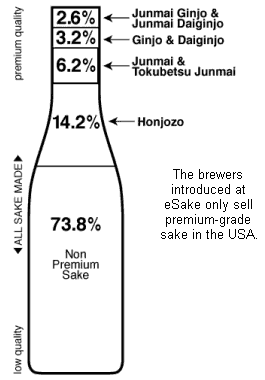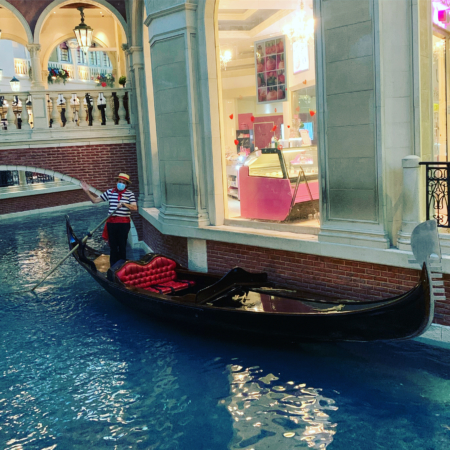

VINO LAS VEGAS attended the first Sake Fever a few years ago and could not wait for it to return. Recently Sake Fever returned in a big way with 150 Premium Sakes and brewmaters to the Palms Pool and Bungalows.
Sake is a whole way of life and anyone who enjoys Sake should learn about how its made and what the " language " of Sake as well.


Sake or saké (pronouned /ˈsɑːkeɪ/ in English is a alholic Japanese beverage made from rice.
This beverage is called sake in English, but in Japanese, sake (酒) or o-sake (お酒) refers to alcoholic drinks in general. The Japanese term for this specific beverage is Nihonshu (日本酒), meaning "Japanese sake"

Sake is also referred to in English as rice wine. However, unlike true wine, in which alcohol is produced by fermenting the sugar naturally present in fruit, sake is made through a brewing process more like that of beer. To make beer or sake, the sugar needed to produce alcohol must first be converted from starch.
Sake is produced by the multiple parallel fermentation of rice. The rice is polished to remove the protein and oils from the exterior of the rice grains, leaving behind starch. A more thorough milling leads to fewer congeners and generally a more desirable product.
 Newly polished rice is allowed to "rest" until it absorbs enough moisture from the air not to crack when immersed in water. After this resting period, the rice is washed clean of the rice powder produced during milling and is steeped in water. The length of the soak depends on the degree to which the rice was polished, from several hours or even overnight for an ordinary milling to just minutes for highly polished rice.
Newly polished rice is allowed to "rest" until it absorbs enough moisture from the air not to crack when immersed in water. After this resting period, the rice is washed clean of the rice powder produced during milling and is steeped in water. The length of the soak depends on the degree to which the rice was polished, from several hours or even overnight for an ordinary milling to just minutes for highly polished rice.After soaking, the rice is boiled in a large pot or it is steamed on a conveyor belt. The degree of cooking must be carefully controlled; overcooked rice will ferment too quickly for flavors to develop well and undercooked rice will only ferment on the outside. The steamed rice is then cooled and divided for different uses.
Some of the steamed rice is taken to a culture room and inoculated with kōji mold (麹, Aspergillus oryzae). The mold-laden rice is itself known as kōji and is cultivated until the growth of the fungus reaches the desired level.
When the kōji is ready, the next step is to create the starter mash, known as shubo (酒母), or colloquially, moto (酛). Kōji rice, water, and yeast are mixed together, and in the modern method, lactic acid is added to inhibit unwanted bacteria (in slower traditional methods, lactic acid occurs naturally). Next, freshly steamed rice is added and the yeast is cultivated over 10 to 15 days.
After fermentation, sake is pressed to separate the liquid from the solids. With some sake, a small amount of distilled alcohol, called brewer’s alcohol (醸造アルコール), is added before pressing in order to extract flavors and aromas that would otherwise stay in the solids. With cheap sake, a large amount of brewer’s alcohol might be added to increase the volume of sake produced. Next, the remaining lees (a fine sediment) are removed, and the sake is carbon filtered and pasteurized. The sake is allowed to rest and mature and then it is usually diluted with water to lower the alcohol content from around 20% to 15% or so, before finally being bottled.
 The three types of special designation sake
The three types of special designation sake- Honjōzō-shu (本醸造酒), in which a slight amount of brewer's alcohol is added to the sake before pressing, in order to extract extra flavors and aromas from the mash. This term was created in the late 1960s to distinguish it, a premium sake, from cheaply made liquors to which large amounts of distilled alcohol were added simply to increase volume. Sake with this designation must be made with no more than 116 liters of pure alcohol added for every 1,000 kilograms of rice.
- Junmai-shu (純米酒), "pure rice sake," made from only rice, water and kōji, with no brewer's alcohol or other additives. Before 2004, the Japanese government mandated that junmai-shu must be made from rice polished down to 70% or less of its original weight, but that restriction has been removed.
- Ginjō-shu (吟醸酒), made from rice polished to 60% or less of its original weight. Sake made from rice polished to 50% or lower is called daiginjō-shu (大吟醸酒).
The term junmai can be added to ginjō or daiginjō, resulting in junmai ginjō and junmai daiginjō. However, as distilled alcohol is added in small amounts to ginjō and daiginjō to heighten the aroma, not to increase volume, a junmai daiginjō is not necessarily a better product than a daiginjō made with brewer's alcohol.


In Japan sake is served chilled, at room temperature, or heated, depending on the preference of the drinker, the quality of the sake, and the season.
Typically, hot sake is a winter drink, and high-grade sake is not drunk hot, because the flavors and aromas will be lost. This masking of flavor is the reason that low-quality sake is often served hot.
Sake is usually drunk from small cups called choko and poured into the choko from ceramic flasks called tokkuri. Saucer-like cups called sakazuki are also used, most commonly at weddings and other ceremonial occasions. Recently, footed glasses made specifically for premium sake have also come into use.
Another traditional cup is the masu, a box usually made of hinoki or sugi, which was originally used for measuring rice. In some Japanese restaurants, as a show of generosity, the server may put a glass inside the masu or put the masu on a saucer and pour until sake overflows and fills both containers.
Aside from being served straight, sake can be used as a mixer for cocktails, such as tamagozake, saketinis, nogasake, or the sake bomb.


Tōji (杜氏) is the job title of the sake brewer. It is a highly respected job in the Japanese society, with tōji being regarded like musicians or painters. The title of tōji was historically passed on from father to son; today new tōji are either veteran brewery workers or are trained at universities. While modern breweries with refrigeration and cooling tanks operate year-round, most old-fashioned sake breweries are seasonal, operating only in the cool winter months. During the summer and fall most tōji work elsewhere, and are commonly found on farms, only periodically returning to the brewery to supervise storage conditions or bottling operations

We have been asked about storage and ageability of Sake. In general, it is best to keep sake refrigerated in a cool or dark room, as prolonged exposure to heat or direct light will lead to spoilage. Sake stored at room temperature is best consumed within a few months after purchase.
After opening the bottle of sake, it is best consumed within 2 or 3 hours.[ It is possible to store in the refrigerator, but it is recommended to finish the sake within 2 days.
This is because once premium sake is opened, it begins to oxidize which affects the taste. If the sake is kept in the refrigerator for more than 3 days, it will lose its "best" flavor. However, this does not mean it should be disposed of if not consumed. Generally, sake can keep very well and still taste just fine after weeks in the fridge. How long a sake will remain drinkable depends on the actual product itself, and whether it is sealed with a wine vacuum top

Sake Fever provided its guests great opportunity to learn about Sake from the Tōji themselves. But the easiest way to know Sake is to learn the Four Basic Components .
RICE : Sake rice is not your regular rice. It is about 3 times more expensive and there are about 60 different types used. But the best of all Sake rice is "Yamada Nishiki".
WATER : Water is 80% of the final product. Sake is made from Rice and requires the essential ingredient of water. This important element is the "Terroir" in Sake because each areas water is slightly different.
KOJI : Koji is a mold spore that is propagated with a special batch of cooked rice . Its enzymes convert STARCH info fermentable SUGARS . Without KOJI this Rice based drink will be like "HORCHATA" which is Cinnamon Rice Milk without Alcohol .
LOVE : This is the Brewers secret where they add their own special touch or love to make their Sake their own. They do this by using different rice , water , koji and different techniques of polishing the rice.


The term "premium sake " is not has hard to find as you may think.
\Ginjo Sake Equals Premium Sake
The term "Ginjo" is synonomous with premium sake, the type of sake exported by eSake's brewers. Ginjo is not a brand name. It is a style (a grade, category, class) of sake. Ginjo sake is to regular sake what single malt scotch is to regular scotch, or what 100 % agave tequila is to regular tequila. Only 8% to 9% of all sake brewed is Ginjo grade. If you see the term "Ginjo" anywhere on the label, it means the sake you're about to drink is better than 90% of all sake out there.

A better way to see the different levels of Sake is our "very own " Sake bottle.
Premium versus Non-Premium Sake
Only the highest grades of sake are exported
to the USA by the brewers introduced at eSake.

 In addition to speaking with these Brewmasters from Japan , guests were able to sample great dishes from wonderfull dining venues such as Little Budda , Naked Fish Sushi & Grill , Island Sushi & Grill , Hyakumi , Shibuya and Japonais
In addition to speaking with these Brewmasters from Japan , guests were able to sample great dishes from wonderfull dining venues such as Little Budda , Naked Fish Sushi & Grill , Island Sushi & Grill , Hyakumi , Shibuya and Japonais
Premium Sakes , a very inviting pool and great dishes provied guests of the 2nd Sake Fever and reason to look forward to Sake Fever # 3 , hopefully next year.


No comments:
Post a Comment